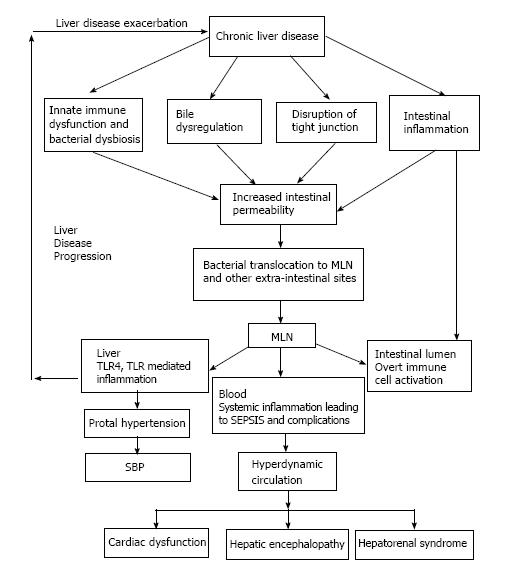Copyright
©The Author(s) 2017.
World J Hepatol. Nov 18, 2017; 9(32): 1210-1226
Published online Nov 18, 2017. doi: 10.4254/wjh.v9.i32.1210
Published online Nov 18, 2017. doi: 10.4254/wjh.v9.i32.1210
Figure 1 Cyclic cascade of bacterial translocation and associated progression of chronic liver diseases and its complications.
The figure enlists the various proposed mechanisms through which chronic liver diseases conditions triggers intestinal permiability and BT. Increased intestinal permeability causes translocation of bacteria across the intestinal epithelium to the MLN and extra-intestinal sites such as liver and blood causing discrete complications in each of the systems. In the intestinal lumen, BT causes overt activation of immune cells and aggravates the pro-inflammatory cytokines in the gut. Translocation of bacteria at pathological levels to MLN is a major risk factor for systemic inflammation which leads to hyperdynamic circulation and is reflected across various organs in the form of complications such as cardiac dysfunction, hepatorenal syndrome and hepatic encephalopathy. Translocation of bacteria to the liver causes TLR4 and TLR9 mediated inflammation which further exacerbates the progression of chronic liver diseases and intestinal permeability. BT to liver also causes portal hypertension, which forms the basis of development of SBP. BT: Bacterial translocation; MLN: Mesenteric lymph node; SBP: Spontaneous bacterial peritonitis.
- Citation: Mohandas S, Vairappan B. Role of pregnane X-receptor in regulating bacterial translocation in chronic liver diseases. World J Hepatol 2017; 9(32): 1210-1226
- URL: https://www.wjgnet.com/1948-5182/full/v9/i32/1210.htm
- DOI: https://dx.doi.org/10.4254/wjh.v9.i32.1210









